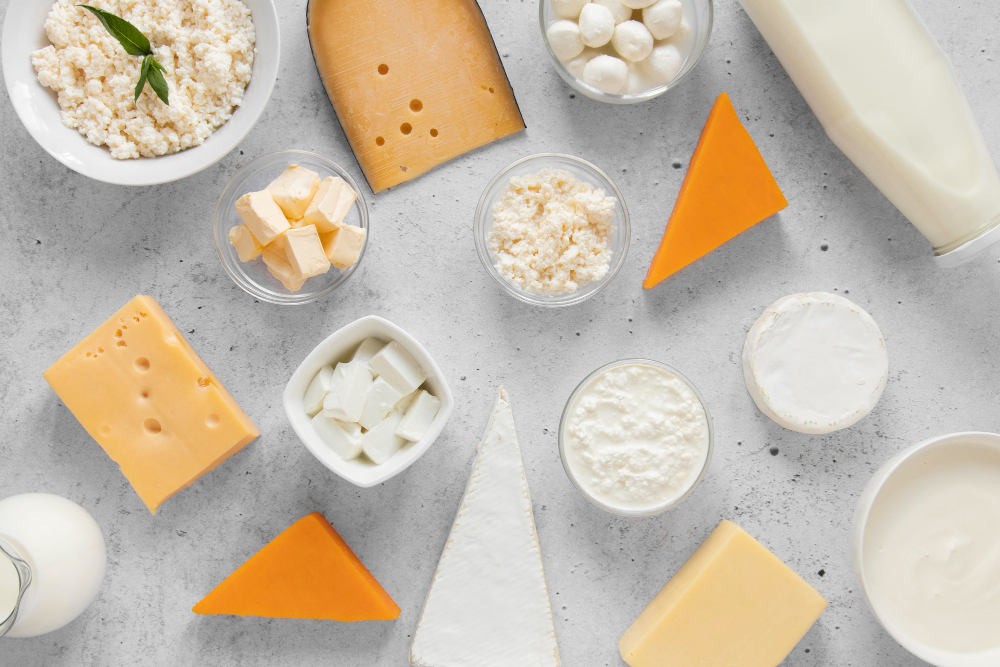
13 Jan The Science Behind Dairy Fermentation: From Milk to Masterpieces
Fermentation is a transformative process that has been at the heart of dairy production for centuries. From the creamy tang of yogurt to the robust flavors of aged cheeses, fermentation turns milk into an array of delectable products. This article explores the scientific principles behind dairy fermentation, unraveling the microbial magic that creates these culinary masterpieces.
What is Dairy Fermentation?
Dairy fermentation is a metabolic process in which microorganisms, primarily bacteria and fungi, convert lactose (milk sugar) into lactic acid and other compounds. This process not only enhances the flavor and texture of dairy products but also extends their shelf life. Commonly used microorganisms include:
- Lactic Acid Bacteria (LAB): Such as Lactobacillus, Streptococcus thermophilus, and Lactococcus lactis.
- Fungi: Including molds like Penicillium species and yeasts like Geotrichum candidum, often used in specific cheese varieties.
The Stages of Dairy Fermentation
- Preparation of Milk:
- The process begins with high-quality milk, which may be standardized to control fat and protein content.
- Pasteurization eliminates pathogens and undesirable microorganisms, ensuring a clean slate for fermentation.
- Addition of Starter Cultures:
- Starter cultures, containing specific strains of LAB or fungi, are added to the milk.
- These microorganisms metabolize lactose, producing lactic acid, which lowers the pH of the milk.
- Curd Formation:
- As the pH drops, casein proteins in the milk coagulate, forming a gel-like structure known as curd.
- This is the foundation for many dairy products, from soft curds used in yogurt to firm structures needed for cheese.
- Texture and Flavor Development:
- Additional enzymes and microbial activity break down proteins and fats, creating unique textures and complex flavors.
- For example, the nutty notes in aged Gouda or the tangy taste of kefir arise from microbial byproducts like diacetyl and acetoin.
- Maturation and Aging:
- In products like cheese, controlled aging allows secondary fermentation processes to occur.
- During this stage, molds and bacteria contribute to the development of rind, aroma, and flavor.
Factors Influencing Fermentation
Several factors must be carefully managed to achieve desired results:
- Temperature: Most LAB thrive at specific temperatures, typically between 20–45°C. Temperature deviations can lead to inconsistent fermentation.
- pH: Monitoring acidity levels ensures the proper progression of fermentation and inhibits spoilage organisms.
- Microbial Strains: The choice of microorganisms directly impacts the flavor, texture, and characteristics of the final product.
- Time: The duration of fermentation determines the intensity of flavors and the firmness of textures.
Products of Dairy Fermentation
- Yogurt:
- Fermented using Lactobacillus delbrueckii subsp. bulgaricus and Streptococcus thermophilus, yogurt is known for its creamy texture and tangy taste.
- Cheese:
- Cheeses like Cheddar, Brie, and Blue Cheese undergo complex fermentation and aging processes to achieve their unique profiles.
- Kefir:
- A fermented milk drink containing probiotics, kefir is produced using a symbiotic culture of bacteria and yeasts (SCOBY).
- Butter and Cream:
- Cultured butter and cream derive their distinctive tang from fermentation with LAB.
Benefits of Dairy Fermentation
- Enhanced Flavor and Texture:
- Fermentation introduces complex flavors and improves the creaminess or firmness of products.
- Improved Digestibility:
- Lactic acid bacteria break down lactose, making fermented dairy more suitable for individuals with lactose intolerance.
- Probiotic Properties:
- Many fermented dairy products contain live beneficial bacteria that support gut health.
- Extended Shelf Life:
- The acidic environment created during fermentation inhibits the growth of spoilage microorganisms.
Challenges in Dairy Fermentation
- Contamination:
- Maintaining sterile conditions is crucial to prevent undesirable microorganisms from spoiling the product.
- Microbial Stability:
- Variations in starter culture activity can lead to inconsistent results.
- Temperature Control:
- Fluctuations in temperature can disrupt the fermentation process, affecting the quality of the final product.
Conclusion
The science of dairy fermentation is a delicate interplay of microbiology, chemistry, and craftsmanship. By harnessing the power of microorganisms, milk is transformed into an astonishing variety of products, each with its own unique taste, texture, and nutritional benefits. As research and innovation continue, the art of fermentation promises to unlock even more possibilities, enriching our culinary experiences and enhancing our understanding of this ancient yet ever-evolving process.


